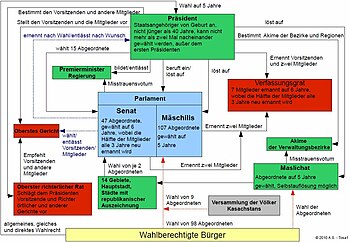Political system of Kazakhstan
The political system of Kazakhstan is from authoritarianism marked. Kazakhstan has been independent from the Soviet Union since 1991 . Before that, the area was part of the USSR as the Kazakh SSR . Kazakhstan has had its own republican constitution since 1995 .
Constitution
The Constitution of Kazakhstan was adopted in 1995. Kazakhstan is therefore a secular , democratic and social constitutional state . Several constitutional amendments restricted the power of parliament and the government and expanded the powers of the President.
Institutions
The legislative rights are both the government and the Parliament . Both have the right to initiate legislation.
government
The President is the head of state of Kazakhstan and determines the guidelines of politics, as he is endowed with extensive powers. He can only be re-elected once. After the constitutional amendment in 2007, this no longer applied to First President Nursultan Nazarbayev , who had ruled the country since December 1, 1991. For this, his term of office was reduced from seven to five years. The current president has been Qassym-Shomart Toqayev since March 20, 2019 . There is also the office of Prime Minister . Asqar Mamin has held this office since February 2019 .
The president is elected directly by the people for a five-year term. He has the right to appoint the Prime Minister and the Vice Prime Minister, as does the Council of Ministers. Only the president can appoint and dismiss the government, dissolve parliament, amend the constitution, and call referendums. He (or she) has the right to initiate legislation and can veto Parliament's bills. Likewise, the Äkims (governors) of the oblasts (areas) and the independent cities are appointed by him (or her). The President is also the Commander in Chief of the Armed Forces .
houses of Parliament

Parliament has the right to initiate legislation, although most of Parliament's laws are enacted on the proposal of the government. It consists of two chambers, an upper house (Senate) and a lower house. The lower house - the Mäschilis - comprises 107 seats, of which 98 are filled every 4 years by direct election and 9 (as representatives of the ethnic minorities) proportionally by appointment by the President. There is a 7 percent threshold clause in the parliamentary elections. In the last parliamentary elections in August 2012 , President Nur Otan's party won 83 seats with 81 percent of the vote. The Organization for Security and Cooperation in Europe (OSCE) criticized the course of the election. It was praised, however, that for the first time two other parties made it into parliament. Since Kazakhstan's independence in 1991, the ruling party has occupied all seats in parliament. Due to a constitutional amendment, the second-placed party would have entered parliament according to its share of the vote, even without overcoming the 7% hurdle.
The House of Lords has 47 seats. Of these, 32 are elected by the regional parliaments and 15 are appointed directly by the President. (see main article Senate of the Republic of Kazakhstan )
Judiciary
At the head of the judiciary is the Supreme Court. The Supreme Court has 44 judges. There is also a constitutional court, the so-called Constitutional Council , which has a total of 7 members. The 1999 elections were declared unconstitutional.
Parties
The dominant party in the Republic of Kazakhstan is the currently ruling presidential party Nur Otan . It is closely linked to the state apparatus and has the characteristics of a ruling party (founded on the initiative of the President, all important politicians are members). However, since Kazakhstan has a multi-party system, there are numerous parties:
- Nur Otan : Presidential party, holds all important political offices in the country
- Democratic Party Ak Schol : Party of the center, loyal to the state
- Communist People's Party of Kazakhstan : A split from the CP, but also with a social democratic orientation
- Democratic Patriotic People's Party Auyl
- National Social Democratic Party : Sharmachan Tujaqbai leadership , registered on January 25, 2007, is in opposition; Merger of Asat and the National Social Democratic Party of Kazakhstan
- Birlik : Merger of the parties Adilet and Ruchanijat
Among other things, the following are prohibited:
- Alash party : classified as fascistoid
- Asat : since March 17, 2006, registration has been revised by the Supreme Court of Kazakhstan
- Turkestan Islamic Party : Islamist
- Communist Party of Kazakhstan : Banned since 2015
Web links
- Foreign Office: Domestic Policy of Kazakhstan
- Democracy in Kazakh , Die Presse Online, August 17, 2007

